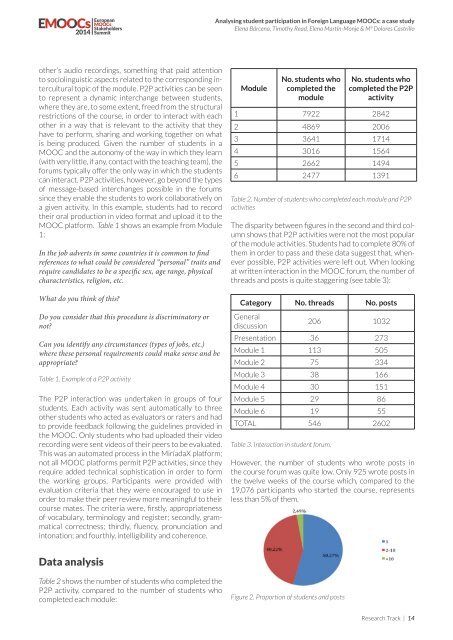zmWmQs
zmWmQs
zmWmQs
You also want an ePaper? Increase the reach of your titles
YUMPU automatically turns print PDFs into web optimized ePapers that Google loves.
Analysing student participation in Foreign Language MOOCs: a case study<br />
Elena Bárcena, Timothy Read, Elena Martín-Monje & Mª Dolores Castrillo<br />
other’s audio recordings, something that paid attention<br />
to sociolinguistic aspects related to the corresponding intercultural<br />
topic of the module. P2P activities can be seen<br />
to represent a dynamic interchange between students,<br />
where they are, to some extent, freed from the structural<br />
restrictions of the course, in order to interact with each<br />
other in a way that is relevant to the activity that they<br />
have to perform, sharing and working together on what<br />
is being produced. Given the number of students in a<br />
MOOC and the autonomy of the way in which they learn<br />
(with very little, if any, contact with the teaching team), the<br />
forums typically offer the only way in which the students<br />
can interact. P2P activities, however, go beyond the types<br />
of message-based interchanges possible in the forums<br />
since they enable the students to work collaboratively on<br />
a given activity. In this example, students had to record<br />
their oral production in video format and upload it to the<br />
MOOC platform. Table 1 shows an example from Module<br />
1:<br />
In the job adverts in some countries it is common to find<br />
references to what could be considered “personal” traits and<br />
require candidates to be a specific sex, age range, physical<br />
characteristics, religion, etc.<br />
What do you think of this<br />
Do you consider that this procedure is discriminatory or<br />
not<br />
Can you identify any circumstances (types of jobs, etc.)<br />
where these personal requirements could make sense and be<br />
appropriate<br />
Table 1. Example of a P2P activity<br />
The P2P interaction was undertaken in groups of four<br />
students. Each activity was sent automatically to three<br />
other students who acted as evaluators or raters and had<br />
to provide feedback following the guidelines provided in<br />
the MOOC. Only students who had uploaded their video<br />
recording were sent videos of their peers to be evaluated.<br />
This was an automated process in the MiríadaX platform;<br />
not all MOOC platforms permit P2P activities, since they<br />
require added technical sophistication in order to form<br />
the working groups. Participants were provided with<br />
evaluation criteria that they were encouraged to use in<br />
order to make their peer review more meaningful to their<br />
course mates. The criteria were, firstly, appropriateness<br />
of vocabulary, terminology and register; secondly, grammatical<br />
correctness; thirdly, fluency, pronunciation and<br />
intonation; and fourthly, intelligibility and coherence.<br />
Module<br />
Table 2. Number of students who completed each module and P2P<br />
activities<br />
The disparity between figures in the second and third column<br />
shows that P2P activities were not the most popular<br />
of the module activities. Students had to complete 80% of<br />
them in order to pass and these data suggest that, whenever<br />
possible, P2P activities were left out. When looking<br />
at written interaction in the MOOC forum, the number of<br />
threads and posts is quite staggering (see table 3):<br />
Category No. threads No. posts<br />
General<br />
discussion<br />
No. students who<br />
completed the<br />
module<br />
206 1032<br />
Presentation 36 273<br />
Module 1 113 505<br />
Module 2 75 334<br />
Module 3 38 166<br />
Module 4 30 151<br />
Module 5 29 86<br />
Module 6 19 55<br />
TOTAL 546 2602<br />
Table 3. Interaction in student forum.<br />
No. students who<br />
completed the P2P<br />
activity<br />
1 7922 2842<br />
2 4869 2006<br />
3 3641 1714<br />
4 3016 1564<br />
5 2662 1494<br />
6 2477 1391<br />
However, the number of students who wrote posts in<br />
the course forum was quite low. Only 925 wrote posts in<br />
the twelve weeks of the course which, compared to the<br />
19,076 participants who started the course, represents<br />
less than 5% of them.<br />
Data analysis<br />
Table 2 shows the number of students who completed the<br />
P2P activity, compared to the number of students who<br />
completed each module:<br />
Figure 2. Proportion of students and posts<br />
Research Track | 14


